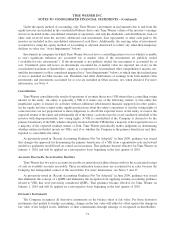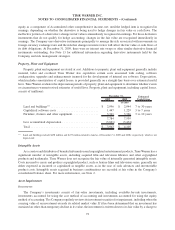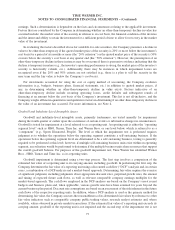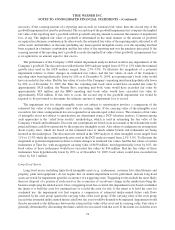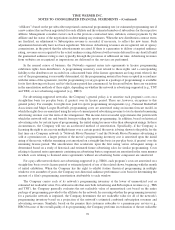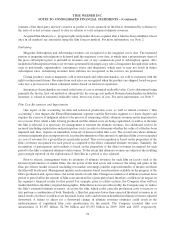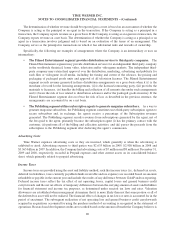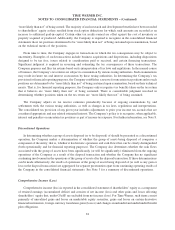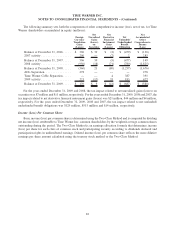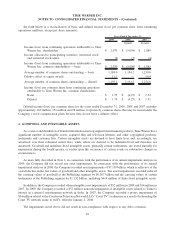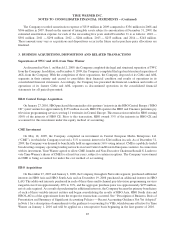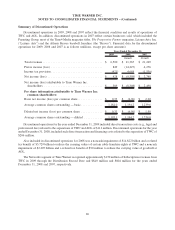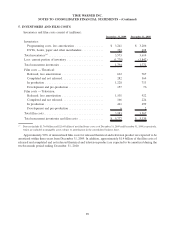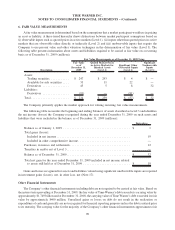Time Magazine 2009 Annual Report Download - page 93
Download and view the complete annual report
Please find page 93 of the 2009 Time Magazine annual report below. You can navigate through the pages in the report by either clicking on the pages listed below, or by using the keyword search tool below to find specific information within the annual report.“more likely than not” of being earned. The majority of such research and development benefits have been recorded
to shareholders’ equity as they resulted from stock option deductions for which such amounts are recorded as an
increase to additional paid-in-capital. Certain other tax credits earned are offset against the cost of inventory or
property acquired or produced. Additionally, the Company is required to recognize in the consolidated financial
statements those tax positions determined to be “more likely than not” of being sustained upon examination, based
on the technical merits of the positions.
From time to time, the Company engages in transactions in which the tax consequences may be subject to
uncertainty. Examples of such transactions include business acquisitions and dispositions, including dispositions
designed to be tax free, issues related to consideration paid or received, and certain financing transactions.
Significant judgment is required in assessing and estimating the tax consequences of these transactions. The
Company prepares and files tax returns based on its interpretation of tax laws and regulations. In the normal course
of business, the Company’s tax returns are subject to examination by various taxing authorities. Such examinations
may result in future tax and interest assessments by these taxing authorities. In determining the Company’s tax
provision for financial reporting purposes, the Company establishes a reserve for uncertain tax positions unless such
positions are determined to be “more likely than not” of being sustained upon examination, based on their technical
merits. That is, for financial reporting purposes, the Company only recognizes tax benefits taken on the tax return
that it believes are “more likely than not” of being sustained. There is considerable judgment involved in
determining whether positions taken on the tax return are “more likely than not” of being sustained.
The Company adjusts its tax reserve estimates periodically because of ongoing examinations by, and
settlements with, the various taxing authorities, as well as changes in tax laws, regulations and interpretations.
The consolidated tax provision of any given year includes adjustments to prior year income tax accruals that are
considered appropriate and any related estimated interest. The Company’s policy is to recognize, when applicable,
interest and penalties on uncertain tax positions as part of income tax expense. For further information, see Note 8.
Discontinued Operations
In determining whether a group of assets disposed (or to be disposed) of should be presented as a discontinued
operation, the Company makes a determination of whether the group of assets being disposed of comprises a
component of the entity; that is, whether it has historic operations and cash flows that can be clearly distinguished
(both operationally and for financial reporting purposes). The Company also determines whether the cash flows
associated with the group of assets have been significantly (or will be significantly) eliminated from the ongoing
operations of the Company as a result of the disposal transaction and whether the Company has no significant
continuing involvement in the operations of the group of assets after the disposal transaction. If these determinations
can be made affirmatively, the results of operations of the group of assets being disposed of (as well as any gain or
loss on the disposal transaction) are aggregated for separate presentation apart from continuing operating results of
the Company in the consolidated financial statements. See Note 3 for a summary of discontinued operations.
Comprehensive Income (Loss)
Comprehensive income (loss) is reported in the consolidated statement of shareholders’ equity as a component
of retained earnings (accumulated deficit) and consists of net income (loss) and other gains and losses affecting
shareholders’ equity that, under GAAP, are excluded from net income (loss). For Time Warner, such items consist
primarily of unrealized gains and losses on marketable equity securities, gains and losses on certain derivative
financial instruments, foreign currency translation gains (losses) and changes in unfunded and underfunded benefit
plan obligations.
81
TIME WARNER INC.
NOTES TO CONSOLIDATED FINANCIAL STATEMENTS – (Continued)


